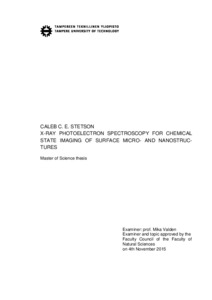X-Ray Photoelectron Spectroscopy for Chemical State Imaging of Surface Micro- and Nanostructures
Stetson, Caleb (2015)
Stetson, Caleb
2015
Master's Degree Programme in Science and Bioengineering
Luonnontieteiden tiedekunta - Faculty of Natural Sciences
This publication is copyrighted. You may download, display and print it for Your own personal use. Commercial use is prohibited.
Hyväksymispäivämäärä
2015-12-09
Julkaisun pysyvä osoite on
https://urn.fi/URN:NBN:fi:tty-201511261814
https://urn.fi/URN:NBN:fi:tty-201511261814
Tiivistelmä
X-Ray Photoelectron Spectroscopy (XPS) is an established surface analysis technique that is unique for its ability to discern the element and chemical state of surface species. This thesis examines copper deposition on an interdigitated microelectrode sample, and focuses upon chemical state imaging of its surface using XPS.
Prior to chemical state imaging measurements, a preliminary objective of this work was to assess the capabilities of the analysis system quantitatively. Measurements of silver foil references were conducted using different apertures, magnifications, and analyzer pass energies. Similarly, a knife-edge sample was measured to quantify the resolution of the analyzer’s deflector lens system.
The interdigitated electrode sample was prepared with a thin copper electrodeposited layer. Initial XPS measurement verified the thickness of the deposition layer, and then images were measured of the sample surface.
Initial results provided information regarding the energy resolution, lateral resolution, and analysis spot size for the analyzer. Results exceeded expectations set by technical manuals. Processed images demonstrated the imaging capabilities of the analyzer.
Lastly, conclusions were drawn from these measurements to direct future measurements. Parameter optimization was presented for imaging and line scans. Furthermore, a theoretical technique was devised to detect and quantify surface features whose dimen-sions are below the resolution limit of the analyzer.
Prior to chemical state imaging measurements, a preliminary objective of this work was to assess the capabilities of the analysis system quantitatively. Measurements of silver foil references were conducted using different apertures, magnifications, and analyzer pass energies. Similarly, a knife-edge sample was measured to quantify the resolution of the analyzer’s deflector lens system.
The interdigitated electrode sample was prepared with a thin copper electrodeposited layer. Initial XPS measurement verified the thickness of the deposition layer, and then images were measured of the sample surface.
Initial results provided information regarding the energy resolution, lateral resolution, and analysis spot size for the analyzer. Results exceeded expectations set by technical manuals. Processed images demonstrated the imaging capabilities of the analyzer.
Lastly, conclusions were drawn from these measurements to direct future measurements. Parameter optimization was presented for imaging and line scans. Furthermore, a theoretical technique was devised to detect and quantify surface features whose dimen-sions are below the resolution limit of the analyzer.
